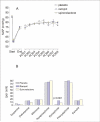Angiotensin-converting enzyme inhibition or mineralocorticoid receptor blockade do not affect prevalence of atrial fibrillation in patients undergoing cardiac surgery
- PMID: 22824930
- PMCID: PMC3588582
- DOI: 10.1097/CCM.0b013e31825b8be2
Angiotensin-converting enzyme inhibition or mineralocorticoid receptor blockade do not affect prevalence of atrial fibrillation in patients undergoing cardiac surgery
Abstract
Objective: This study tested the hypothesis that interruption of the renin-angiotensin system with either an angiotensin-converting enzyme inhibitor or a mineralocorticoid receptor antagonist will decrease the prevalence of atrial fibrillation after cardiac surgery.
Design: Randomized double-blind placebo-controlled study.
Setting: University-affiliated hospitals.
Patients: Four hundred forty-five adult patients in normal sinus rhythm undergoing elective cardiac surgery.
Interventions: One week to 4 days prior to surgery, patients were randomized to treatment with placebo, ramipril (2.5 mg the first 3 days followed by 5 mg/day, with the dose reduced to 2.5 mg/day on the first postoperative day only), or spironolactone (25 mg/day).
Measurements: The primary endpoint was the occurrence of electrocardiographically confirmed postoperative atrial fibrillation. Secondary endpoints included acute renal failure, hyperkalemia, the prevalence of hypotension, length of hospital stay, stroke, and death.
Main results: The prevalence of atrial fibrillation was 27.2% in the placebo group, 27.8% in the ramipril group, and 25.9% in the spironolactone group (p=.95). Patients in the ramipril (0.7%) or spironolactone (0.7%) group were less likely to develop acute renal failure than those randomized to placebo (5.4%, p=.006). Patients in the placebo group tended to be hospitalized longer than those in the ramipril or spironolactone group (6.8±8.2 days vs. 5.7±3.2 days and 5.8±3.4 days, respectively, p=.08 for the comparison of placebo vs. the active treatment groups using log-rank test). Compared with patients in the placebo group, patients in the spironolactone group were extubated sooner after surgery (576.4±761.5 mins vs. 1091.3±3067.3 mins, p=.04).
Conclusions: Neither angiotensin-converting enzyme inhibition nor mineralocorticoid receptor blockade decreased the primary outcome of postoperative atrial fibrillation. Treatment with an angiotensin-converting enzyme inhibitor or mineralocorticoid receptor antagonist was associated with decreased acute renal failure. Spironolactone use was also associated with a shorter duration of mechanical ventilation after surgery.
Trial registration: ClinicalTrials.gov NCT00141778.
Figures




Comment in
-
Precardiac surgery angiotensin-converting enzymes and mineralocorticoid blockers do not trump atrial fibrillation but possibly acute kidney injury: the value of a negative randomized study.Crit Care Med. 2012 Oct;40(10):2908-9. doi: 10.1097/CCM.0b013e31826324d6. Crit Care Med. 2012. PMID: 22986659 No abstract available.
Similar articles
-
Precardiac surgery angiotensin-converting enzymes and mineralocorticoid blockers do not trump atrial fibrillation but possibly acute kidney injury: the value of a negative randomized study.Crit Care Med. 2012 Oct;40(10):2908-9. doi: 10.1097/CCM.0b013e31826324d6. Crit Care Med. 2012. PMID: 22986659 No abstract available.
-
Prevention of Atrial Fibrillation After Atrial Flutter Ablation With Ramipril (from the PREFACE Study).Am J Cardiol. 2022 Jan 1;162:73-79. doi: 10.1016/j.amjcard.2021.09.010. Epub 2021 Oct 31. Am J Cardiol. 2022. PMID: 34728062 Clinical Trial.
-
Double-blind, placebo-controlled study on the effect of the aldosterone receptor antagonist spironolactone in patients who have persistent proteinuria and are on long-term angiotensin-converting enzyme inhibitor therapy, with or without an angiotensin II receptor blocker.Clin J Am Soc Nephrol. 2006 Mar;1(2):256-62. doi: 10.2215/CJN.01040905. Epub 2006 Feb 1. Clin J Am Soc Nephrol. 2006. PMID: 17699214 Clinical Trial.
-
Association of Preoperative Renin-Angiotensin System Inhibitors With Prevention of Postoperative Atrial Fibrillation and Adverse Events: A Systematic Review and Meta-analysis.JAMA Netw Open. 2019 May 3;2(5):e194934. doi: 10.1001/jamanetworkopen.2019.4934. JAMA Netw Open. 2019. PMID: 31150082 Free PMC article.
-
Optimal antagonism of the Renin-Angiotensin-aldosterone system: do we need dual or triple therapy?Drugs. 2010 Jul 9;70(10):1215-30. doi: 10.2165/11537910-000000000-00000. Drugs. 2010. PMID: 20568830 Review.
Cited by
-
Diuretics for preventing and treating acute kidney injury.Cochrane Database Syst Rev. 2025 Jan 29;1(1):CD014937. doi: 10.1002/14651858.CD014937.pub2. Cochrane Database Syst Rev. 2025. PMID: 39878152
-
Publication Speed, Reporting Metrics, and Citation Impact of Cardiovascular Trials Supported by the National Heart, Lung, and Blood Institute.J Am Heart Assoc. 2015 Jul 31;4(8):e002292. doi: 10.1161/JAHA.115.002292. J Am Heart Assoc. 2015. PMID: 26231845 Free PMC article.
-
The Effect of Spironolactone on the Incidence of Contrast-Induced Nephropathy in Patients Undergoing Cardiac Catheterization: Study Design and Rationale.Cardiol Ther. 2018 Jun;7(1):101-106. doi: 10.1007/s40119-018-0112-3. Epub 2018 May 21. Cardiol Ther. 2018. PMID: 29785539 Free PMC article.
-
Acute kidney injury following cardiac surgery: current understanding and future directions.Crit Care. 2016 Jul 4;20(1):187. doi: 10.1186/s13054-016-1352-z. Crit Care. 2016. PMID: 27373799 Free PMC article. Review.
-
Arterial Hypertension, Atrial Fibrillation, and Hyperaldosteronism: The Triple Trouble.Hypertension. 2017 Apr;69(4):545-550. doi: 10.1161/HYPERTENSIONAHA.116.08956. Hypertension. 2017. PMID: 28264920 Free PMC article. Review. No abstract available.
References
-
- Aranki SF, Shaw DP, Adams DH, et al. Predictors of atrial fibrillation after coronary artery surgery. Current trends and impact on hospital resources. Circulation. 1996;94:390–397. - PubMed
-
- Mathew JP, Fontes ML, Tudor IC, et al. A multicenter risk index for atrial fibrillation after cardiac surgery. JAMA. 2004;291:1720–1729. - PubMed
-
- Mathew JP, Parks R, Savino JS, et al. Atrial fibrillation following coronary artery bypass graft surgery: predictors, outcomes, and resource utilization. MultiCenter Study of Perioperative Ischemia Research Group. JAMA. 1996;276:300–306. - PubMed
-
- Amar D, Shi W, Hogue CW, Jr., et al. Clinical prediction rule for atrial fibrillation after coronary artery bypass grafting. J Am Coll Cardiol. 2004;44:1248–1253. - PubMed
Publication types
MeSH terms
Substances
Associated data
Grants and funding
LinkOut - more resources
Full Text Sources
Other Literature Sources
Medical

